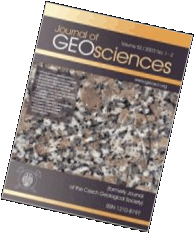 Export to Mendeley
Export to Mendeleygenesis
mineral chemistry
Silesicum
petrography
Desná Group
Sobotín Massif
iron mineralizations
garnetites
cathodoluminescence microscopy
whole-rock geochemistry
Original Paper
The magnetite mineralizations of the Desná Group in the Silesicum, Czech Republic: petrographic, mineralogical, and geochemical studies and their genetic implications
Journal of Geosciences, volume 52 (2007), issue 3-4, 227 - 270
DOI: http://doi.org/10.3190/jgeosci.016
Investigated were occurrences of magnetite-rich rocks (five of which are associated with garnetiferous rocks) situated in the Sobotín Massif (two localities) or in the adjacent gneisses of the Desná Group (six localities). As shown in previous literature, these rocks either belong to iron-formations (six localities) or are of magmatic origin (two localities).
The investigations involved detailed petrographic studies supported by cathodoluminescence microscopy, whole-rock geochemical and mineral (amphibole, biotite, garnet, chlorite, magnetite, ilmenite, carbonate, feldspar and apatite) analyses. The minerals have compositions unknown to iron-formations. Instead they indicate that these may be genetically related to the basic rocks of the ?Devonian Sobotín Massif. Under late-stage and increasing oxygen fugacity conditions of the melt (of the Sobotín Massif), the Fe3+ activity seems to have risen as well. This presumably led to progressive extraction of magnetite from the melt and its enrichment due to gravitational segregation. During this stage, apophyses, mainly composed of amphibole and magnetite, intruded in the gneisses of the Desná Group in the vicinity of the Sobotín Massif. These followed older generations of apophyses that are mainly composed of amphibole only.
The garnet-rich rocks are definitely older than the studied magnetite-rich types and of the same age as the gneisses. The garnetites are inferred to represent original mixtures of precipitates from submarine exhalations and detrital material of continental-derived greywackes. In the absence of local volcanogenic activity, the sedimentary protoliths were composed exclusively of continental-derived material. During a first tectonometamorphic event, the greywacke-derived sediments were transformed into the host-rock gneiss and the mixtures into garnet-rich rocks (= granular iron-formations) identical to coticules.
During a second tectonometamorphic event, all the mentioned rocks were overprinted (alignment and weak foliation of the rocks, chloritization of amphibole and biotite and the formation of actinolite from pre-existing tschermakite and magnesiohornblende, albite, carbonate and epidote). Finally, under retrograde conditions, silicification of varying intensity took place.
Webdesign inspired by aTeo. Hosted at the server of the Institute of Petrology and Structural Geology, Charles University, Prague.
ISSN: 1803-1943 (online), 1802-6222 (print)
email: jgeosci(at)jgeosci.org


IF (WoS, 2024): 1.3
5 YEAR IF (WoS, 2024): 1.4
Policy: Open Access
ISSN: 1802-6222
E-ISSN: 1803-1943